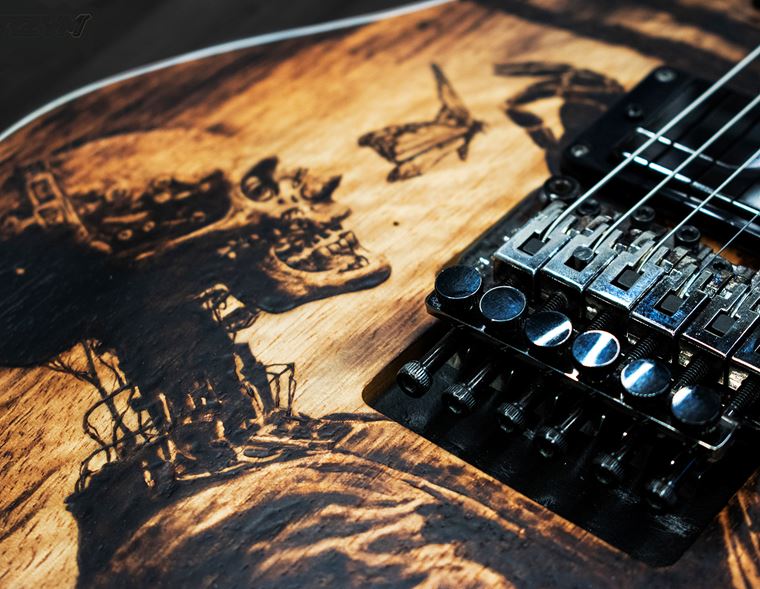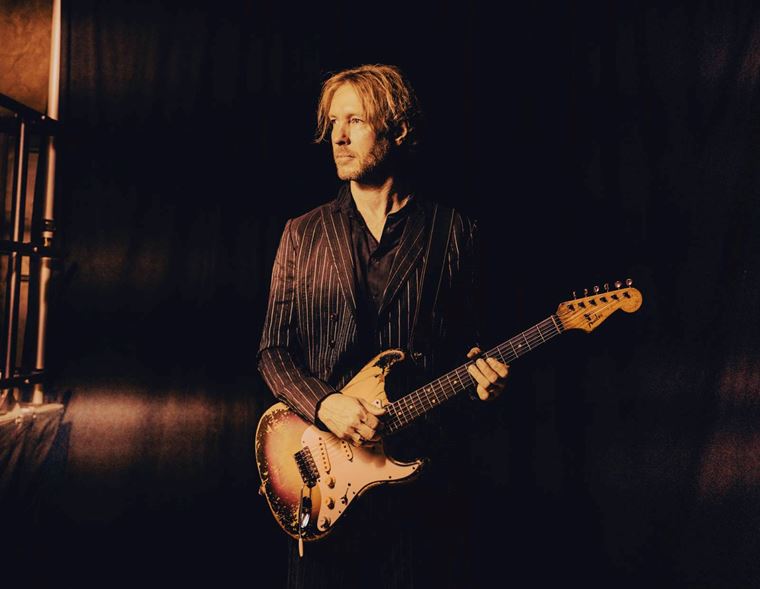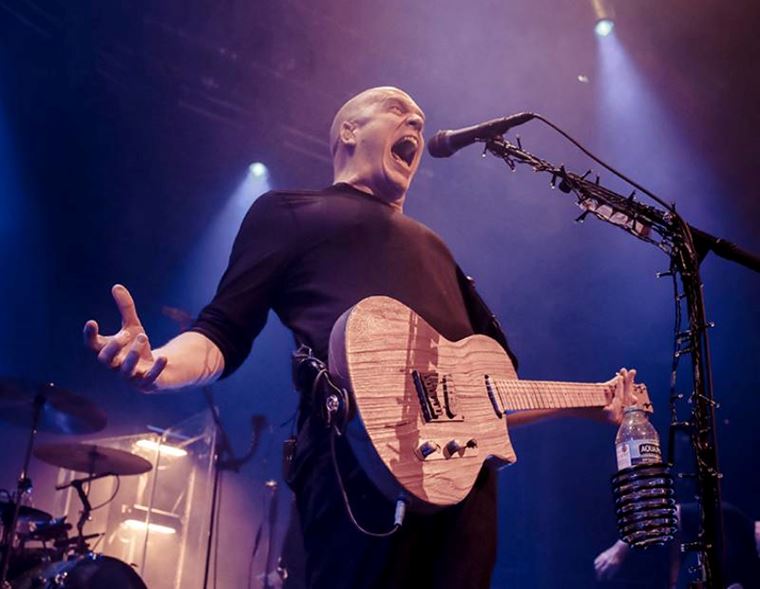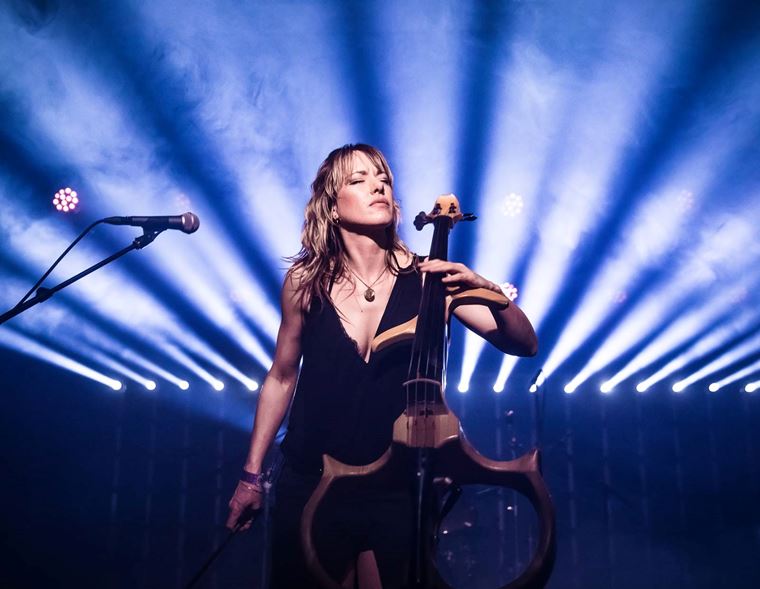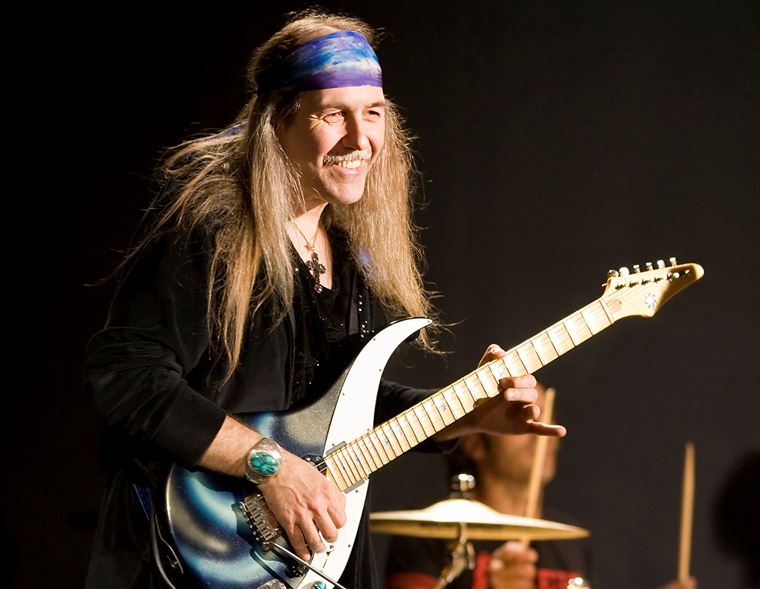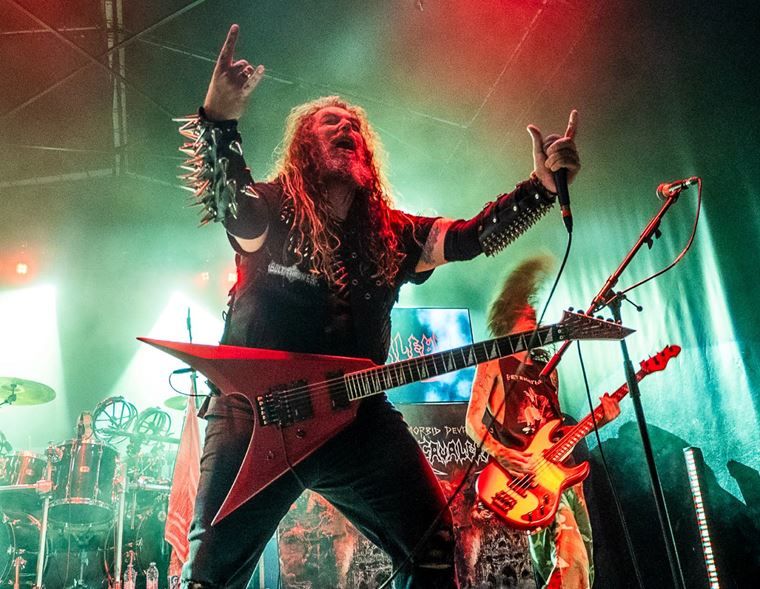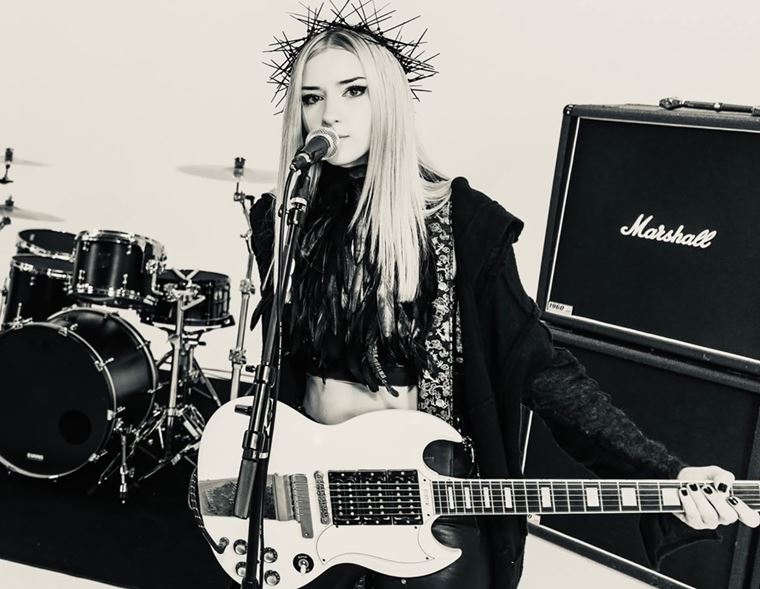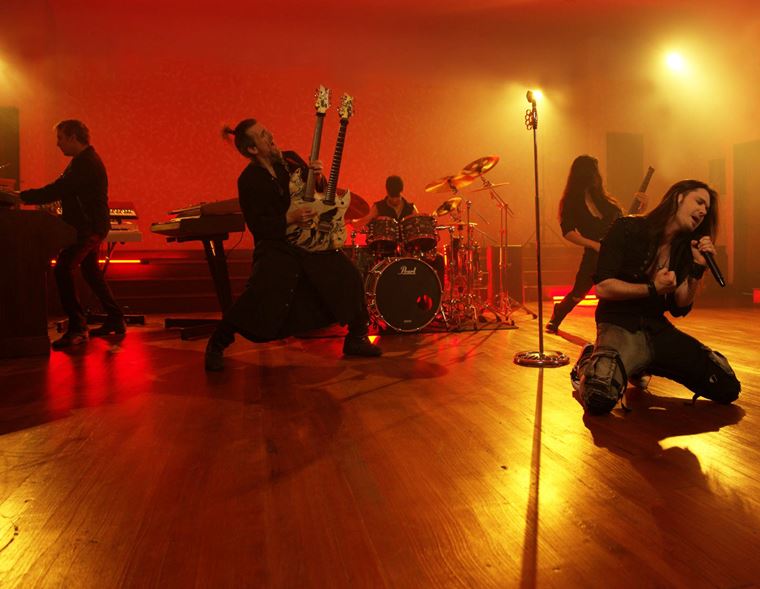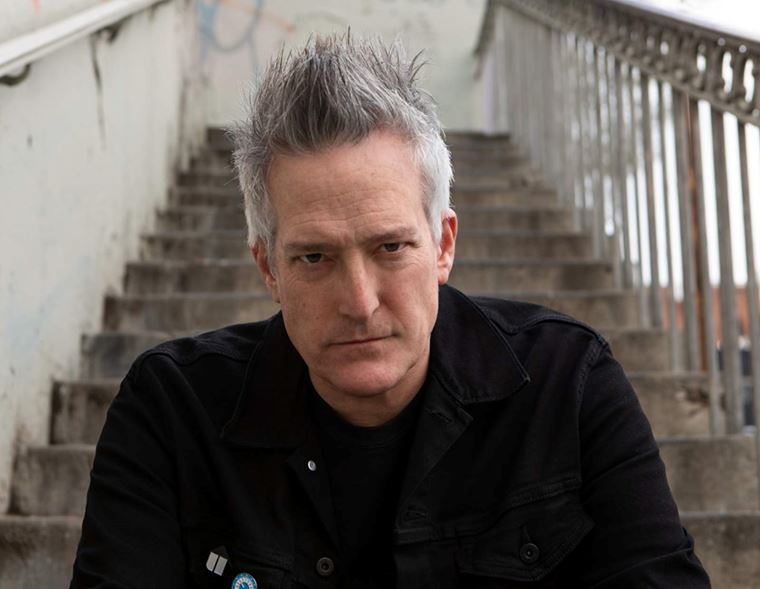The guitarguitar Interview: Rodrigo y Gabriela
You wouldn’t believe the sound that comes from these two people.
Two people, two acoustic guitars, nothing else.
What a sound! Rhythmic, complex swirls of interconnected weaving. Pounding, thumping drums, made only with the palm or fingers of a hand on a guitar’s top. Dextrous, intricate blurs of notes, arpeggios, runs and melodies, all played with passion and flair.
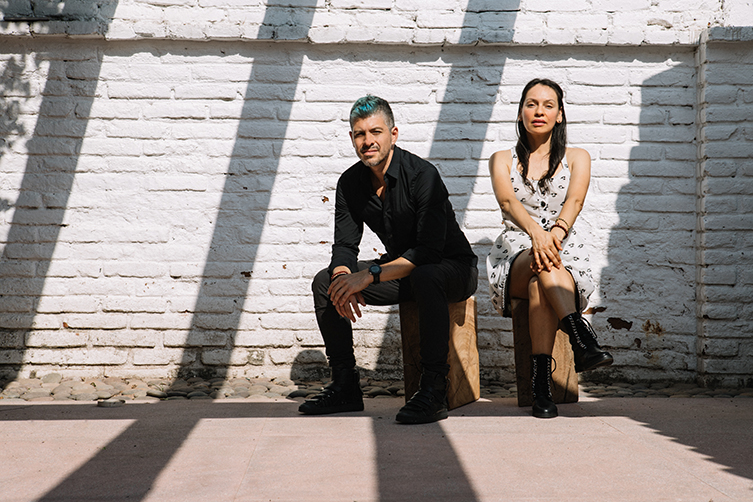
Rodrigo Sánchez and Gabriela Quintero have been doing this for twenty years now. They are masters of their art and have enjoyed a vastly successful career that was seen them play in front of then-US President Barack Obama as well as collaborating with Oscar-winning Hollywood composer Hans Zimmer. It’s all a long way from their beginnings as a duo in Dublin, where Rodrigo and Gabriela busked and played pub gigs after leaving their native Mexico and their metal band Tierra Ácida.
Their style is a melodic, rhythmically dense blend of Latin-influenced melodies, shred and New Age-style playing. They often get lazily compared to Flamenco (a style they both love but do not play), when their music in fact is something else entirely. Theirs is a truly international sound, coloured and informed by the duo’s experiences travelling the world.
I was lucky enough to be invited along to a performance last week, with an interview slot booked, unusually for me, after the show finished. I thought that the artists would be spent and ready for sleep after the amazingly energetic performance I witnessed, but they were in fact lively and energised!
The show itself was a revelation. A full hour and forty minutes of unstoppable acoustic playing, including a bravura cover (all 18 minutes, no less) of Pink Floyd’s epic Echoes. I admit that I wasn’t sure how well my concentration levels would handle that much acoustic guitar, but my concerns were laughably nullified by a kaleidoscopic performance of colour, dynamic, excitement and good vibes. This is music that truly everybody can enjoy, not just guitar aficionados, or indeed ‘World Music’ fans, whatever that ludicrous term really means! The audience danced, sang along to the guitar melodies and generally made a lot of appreciative noise!
After the show, I met up with Carlo, my appointed contact, and together we made our way into the maze of tight staircases and storage areas that make up the inner sanctum of the venue. Upon entering a door I’d never been through before (fate has brought me into this part of the O2 Academy a fair bit in the last few months), I found myself in a large, modern subterranean lounge with a fully fitted kitchen.
Walking towards me with a large smile was Gabriela and behind her, sat with his arms completely submerged in about 9 inches of ice cubes, was Rodrigo. Rodrigo gave me a smile but seemed to still be decompressing after the performance. Gabriela was lively, welcoming me in and ushering me to a seat. She even grabbed my clipboard and interestedly read my typed-up questions, which made me laugh! Both of them seemed to have a pleasing, natural energy to them, which helped me to instantly relax and just enjoy their company.
I was secretly hoping to somehow gain some one on one insights into Gabriela’s incredible rhythmic strumming techniques. Would there be time? Would it be cheeky to ask? Pleasingly, both of their primary touring guitars were sitting close by, with the cases open, just waiting...
Rodrigo joined us at the sofa after cooling down his arms for a few more minutes and we had an excellent three-way conversation, with each of us frequently descending into laughter. As you’ll find out, we covered a fair amount of ground, from straightforward guitar stuff to more esoteric subjects, things that perhaps don’t often pop up in ‘guitar’ interviews. For me, this kind of detail is the whole point: veering off the trodden path and into more interesting territories. I found both Rodrigo and Gabriela to be more than capable of taking this conversation trip with me!
A good part of the interview revolves around percussion techniques, which are understandably difficult to translate into readable text! I hope you get a flavour for what they say, since sharing is, as you’ll also read, a high priority for these guys. Because much of this is a three-way conversation, I’ve decided to put my questions and comments in bold, I order to more easily scan who is saying what.
Here’s pretty much exactly how it went...

Guitarguitar: So, this is one of those ones where I do have questions: sometimes I get to them, sometimes I don’t!
Gabriela Quintero: Hahaha!
GG: So, (referring to the large container of ice that Rodrigo’s arms have been plunged into) do you have to do this after every show with the ice?
Rodrigo Sánchez: Yes.
GG: No wonder!
GQ: Me too. Usually I am the one who goes first.
GG: So, I was looking into the concepts behind the new record, Mettavolution.
RS: Yeah.
GG: And about how there’s a kind of, uh, theme of the liberation of the human species’ potential, the Buddhism angle, and I was thinking about how that comes out as an artistic statement. Is that more of a kind of inward journey?
Both: Yeah.
GG: I was thinking of a kind of Joseph Campbell ‘Power of Myth’ kind of thing?
GQ: Yeah, yeah absolutely! Yeah, because I think that when you go into this world of ‘non-form’ and all of that, everything becomes non-concrete and so subjective, but, um, yeah the way nowadays that I like to see the album in a way is that it is the journey that Joseph Campbell talks about: it is your life, you know? For this, probably where it is projecting, everything we experience is projected on the outside, you know? It’s wrong: what we bring from within, in a way, is what’s important, youknow?
GG: Yeah, yeah. I was thinking about the Hero’s Journey, because it kinda relates to you guys: the metal band out in Mexico City who relocated to Europe, far away in a land you didn’t know. It’s kind of like what Campbell says about, if you have a big monster, you have to turn around and face it. If you defeat it, you gain its power. That reminds me of the journey you took all those years ago.
GQ: Mmm-hmm.
GG: Is that part of the idea that informs Mettavolution?
RS: I think so, I think it is. I mean, the album, the concept in general is like, it’s probably a consequence of these years but it’s more about ‘this time’, you know? The time that we are going through. Ten years, fifteen years ago, we were not aware of all the spiritual side, you know what I’m saying?
GG: Yeah, definitely.
RS: We were more, um, a had to find a way to survive and during that time we listened to our inner selves, but we were not aware, really, of what we were doing.
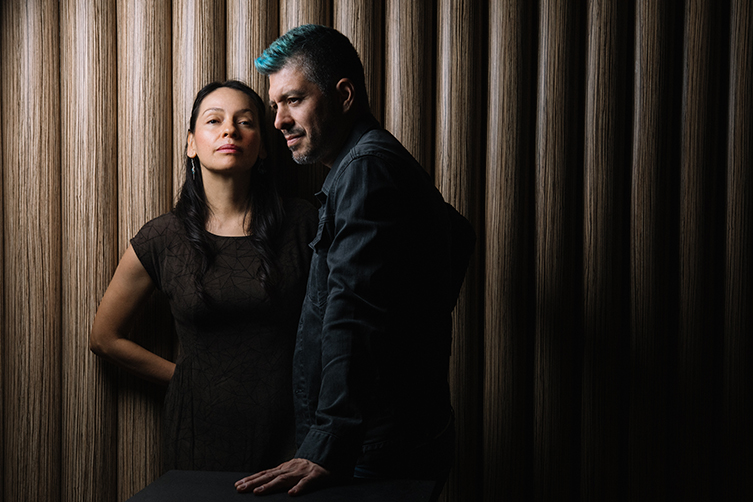
GG; It’s like you’re walking the path without realising you’re walking the path.
RS: Yes, exactly.
GQ: But what you said about Joseph Campbell is like, I’m a big fan if his...
GG: Oh, really? Me too!
GQ: Yes! And The Journey of a Thousand Heroes (Hero With a Thousand Faces, arguably Campbell’s most famous book) and all of the studies he was able to make with the mythology, it’s incredible! And these fears are these monsters, or dragons, whatever the journey is, or the story is, it’s all your fears. And most of the time, those fears are completely not real, completely illusion. It’s just about having the courage to face them. In a way, that’s exactly what we did. At that time, we were not so aware, even though at the time I still read some crazy shit like the Kybalion (Hermes Trismegistus’ teachings on Hermetic Philosophy) hahaha, but nowadays we are both more immersed into all of these texts.
GG: The act of doing that, though...if you guys stayed in Mexico City, played in your band, got other jobs, that would’ve been not walking the true path.
GQ: Exactly! For us, the fear of going away abroad was a monster we had to face. But, for us, there was even a worse monster: which was if we were going to stay. Because for us to stay meant the worst, most horrible monster! It was worse than the monster we had to face, you know?
GG: Yeah, yeah!
GQ: And when you are in that moment of ‘Oh fuck!’, if you stay, the idea of ‘what am I going to do with my life?’ is more scary! For us, it was more scary.
GG: It was scary either way, but you chose the better scary path.
Both: Haha, yes!
GG: So, of course this is for guitarguitar, so I want to talk about guitars with you guys!
Both: Yeah!
GG: Still Yamahas for both of you?
Both: yeah!
GG: So, I’ve had about four nylon string guitars. I’ve accepted that I like them, but they don’t like me very much.
RS: Haha!
GG: But you guys, presumably, were electric guitar players prior to moving over to nylon strings?
GQ: Mm-hmm.
RS: Yeah, that’s right.
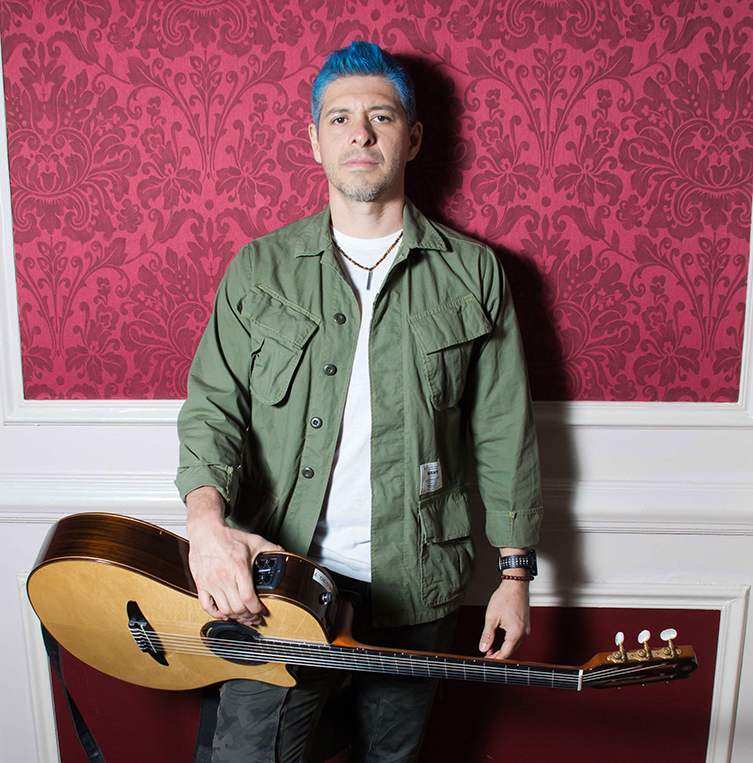
GG: With your technique, Rodrigo, you can see a lot of ‘Metal’ in it.
RS: Oh, yeah yeah yeah.
GG: So, some of it is transferable, but a lot isn’t. Since you had to become a band together with just the two of you, how did you make that work?
RS: I mean, long story short, after the band, we left Mexico and came here and we wanted to...we were so used to playing with the band that, when we were playing on our own, we felt like we were missing the sound.
GG: Pieces missing.
RS: Exactly. So, we developed this thing when we were in Ireland, based a lot of the bodhran (taps his thighs to simulate playing the bodhran), people thought for many years that we were playing flamenco but, we love flamenco, but it was nothing to do with it.
GG: It’s specifically different.
RS: Yeah, exactly. And so, Gabriela kind of became the drummer, you know, and the bass player.
GG: Yeah, and rhythm guitarist, all in one!
GQ: Hahaha!
RS: Yeah, and so we decided at the beginning, we were trading guitar parts and Gabriela used to play very well with a pick but at some point, we decided to stick to what we play best, each of us. And that’s the beauty of this particular setup: because now, it’s not that unique, there are other people doing it, and we were not the only ones back then, but we were one of the pioneers of this style of...breaking the rules.
GG: Yes, definitely.
RS: On acoustic instruments, twenty years ago. Uh, but, I mean, it is still unique for us. A lot of people have suggested through the years like, ‘add some vocals’ and we’ve done that for a joke, and maybe for different projects, but not for the Rod and Gab.
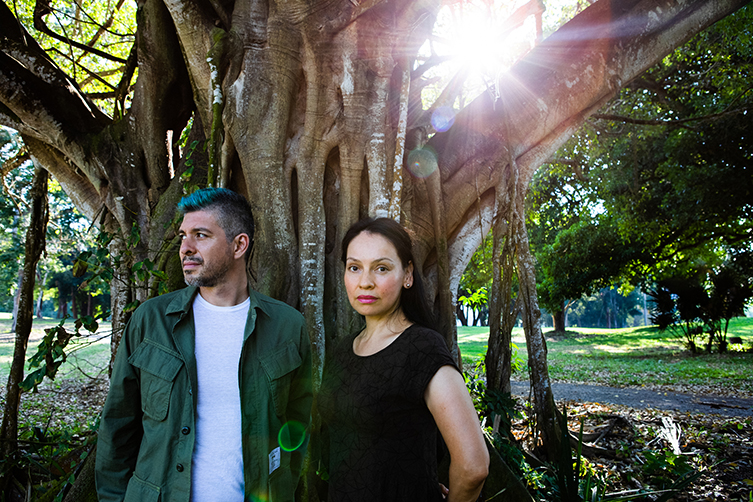
GG: Well, with you guys, it’s like...that show there was an hour and a half of the most exciting acoustic guitar music that I could possibly have heard. I wondered what an entire show would be like, but it was thrilling, even all the mad ambient sounds on ‘Echoes’!
GQ: All that crazy stuff hahaha!
GG: It’s like stuff I would expect out of Jonny Greenwood’s electric guitar, not a nylon string acoustic, haha! One thing I wanted to ask about is those big ‘kick drum’ noises.
GQ: Yeah, yeah! (Gabriela grabs her guitar out of the case and sits back down)
GG: It sounds insane! (Rod and Gab laugh) Are you honestly just hitting the body of the guitar?
GQ: Yes, because one of the things is, we always try to play, like whatever we do on an album, we can play live acoustically.
GG: Without backing tracks and stuff.
GQ: Yeah, it needs to come from the two of us. That rhythm (the ‘kick and snare’-type technique which is a trademark for Gabriela) that actually, back in the day I did want to play like a flamenco player, but I didn’t know how to! Because you see those guys playing and you’re like (puts on a sad voice) ‘what are they doing’? And I was trying to figure it out, and I always got it wrong. Because it’s all based on the roll (a flamenco right hand technique called a rasqueado) and when you come from Rock n Roll, that’s the music we listen to the most, for me it’s easier to just go into the more ‘Rock’ fill naturally, so (taps the guitar’s top) this is the rhythm. The big thumb, I always do like this (demonstrates hitting the top near the bridge).
GG: Where are you hitting there, is that right on the strings?
GQ: Mm-hm!
GG: Ah! From out in the audience, I thought you were hitting it up here (gestures towards wood above bridge).
GQ: No, because this is where the pickup is.
GG: Ah, the piezo under the bridge!
GQ: The piezos are here (points to another area of guitar’s top) and the pickup is under here. My guitar has a lot of piezo’s, but it also has a pickup.
RD: She has 7 and my guitar has 5.
GQ: So you can play around (taps the body in various places).
(The next part doesn’t really translate well to text, since it relates to Gabriela percussively tapping the guitar and hitting the strings. The takeaway is that the huge, booming bass noise comes when you hit the strings with your thumb near the bridge, right over the sound hole. The ‘snare’ sounds are from tapping the upper shoulder with your fingertips.)

GG: When you guys are doing something complicated and that kind of ‘drum thing’ drops in, it’s so satisfying.
GQ: Yeah, yeah because it comes back to normal. And when Rod is doing a riff, I can... (plays the rhythm again).
GG: Sounds like John Bonham!
RS: Yeah, Led Zeppelin!
GG: That’s so good! So you just decided ‘I really need to get some drums happening’?
GQ: Yes, and I think it was partly because Rod wrote so many riffs! I thought: how am I gonna be able to complement that? And it was just a riff, so how can you...you cannot just do arpeggios, hahaha!
GG: Yeah, so it’s a case of what do you do on the same instrument to compliment it, yeah?
GQ: Yeah! So that’s why guitar is such an amazing instrument!
RS: A challenge.
GG: Yeah. It worked!
GQ: It worked! Hahaha!
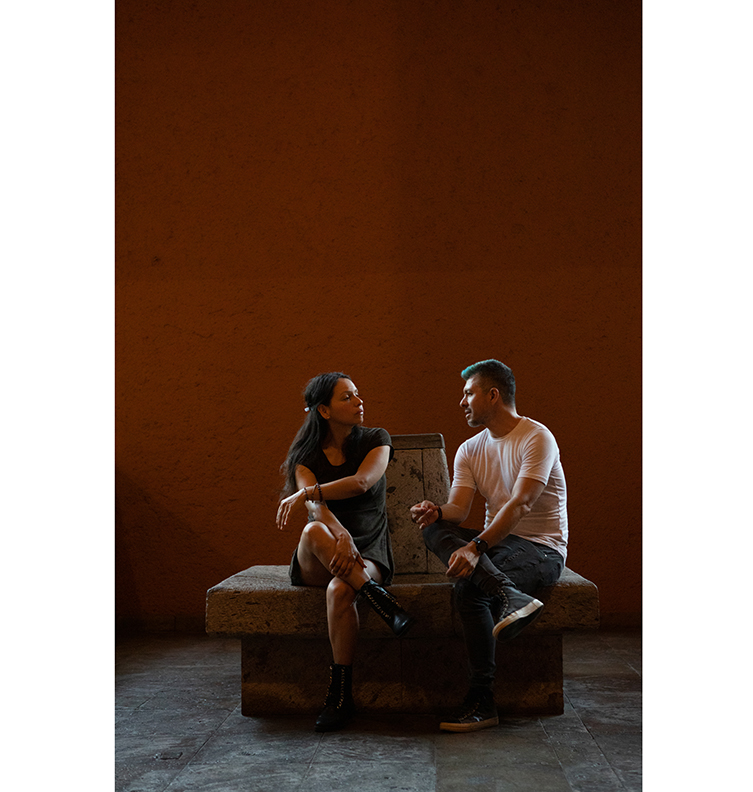
GG: So, we’ve spoken of how you were both in a Metal band in Mexico, and, listening to your music, it’s kind of obvious that you’re a Rock band more than anything else, it’s just that it’s on acoustic guitars.
Both: Yeah.
GG: So, a lot of what you do, like the speedy legato passages, the bent notes and so on: there aren’t so many people doing that these days on acoustic guitars!
RS: Yeah, yeah!
GG: It’s kind of unusual!
RS: Yeah, it’s unusual.
GG: I was also surprised that there was the Jaguar tonight! (Rodrigo occasionally played a nice Lake Placid Blue Fender Jaguar electric guitar instead of his Yamaha nylon string acoustic)
RS: Yeah, because the album has it!
GG: I thought that! I thought I heard it on ‘Echoes’, but when you played that tonight, it was all on the acoustic!
RS: Yeah, half of it, exactly, yeah. The album has both: every song has acoustic and Jaguar. I decided to bring it. For me, it’s great to be able to change the texture, you know? I love it! It’s an amazing guitar, and it was a present! I got it recently from my friend who collects guitars. It was my birthday and it was the most surprising birthday present I ever got!
GG: Not a bad birthday present!
RS: Yeah man! I was looking for a Jaguar after the recording. My guy in the studio was helping me to get it, and just, you know, they weren’t the right ones. Soon, my friend knew that I wanted one and went, ‘here you go! Here it is!’

GG: Wow! I was gonna ask why you picked the Jaguar in particular. It’s a beautiful sounding guitar, but they’re quite idiosyncratic. I’ve found that no two Jaguars are the same.
RS: No. Definitely not! Yeah! You have to try them out. And my friend, because he is a great guitarist, and because he collects guitars, he tried a 67, and this is one of the ones that they remade in 2002, whatever? With the original parts?
GG: Mm-hm.
RS: And he tried a few and said: ’this is the one!’ And when I played it, when I took it to the studio, it was amazing man!
GG: There you go!
RS: Yeah!
GG; So, back to the nylon string guitars. Do you guys have any specific requirements? Like, string gauge? Is it high tension?
RS: Medium.
GQ: Yeah.
GG: Oh, that’s a surprise!
RS: Yeah, they are medium. We’ve been working with D’Addario for years, and the same with Yamaha. What else do we use, the Fractals, well I use Fractal...
GG: Ah, I was gonna ask! So the Axe FX?
RS: Yeah, the Fractals...(to Gabriela) you only use a wah-wah, right? A wah-wah pedal, that’s the only thing?
GQ: The octave. Sometimes.
RS: Yeah, the octave, the Boss.
GQ: Lately I’ve been only using those.
GG: Your live sound, then. Because I was so impressed with that ‘Boomf’! (Rod and Gab laugh) Are you going through any particular kind processing just with your general sound to get that? That’s a lot of bottom end!
RS: Yeah, yeah. It is! It’s something that our engineer has worked on a lot. But there is no trigger or anything, it’s real. It is just a manual thing.
GQ: The hand (technique) and then a good engineer mixing it, will get that.
GG: More bass!
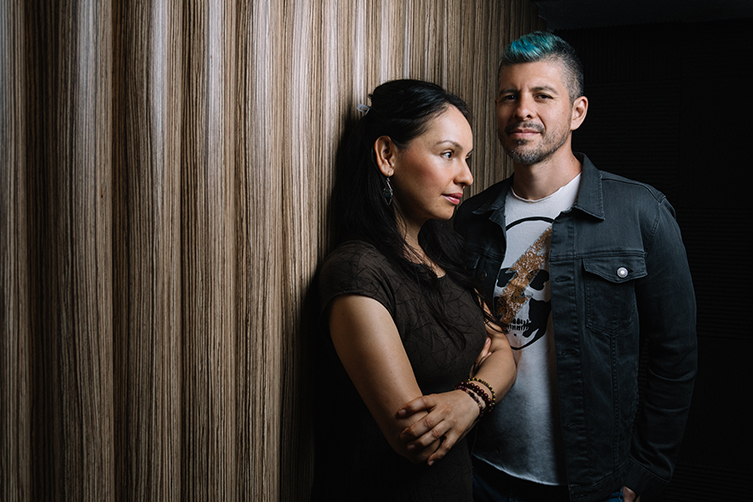
RS: And, of course, we have a stereo output, so he separates the piezos from the pickups.
GG: Oh, got you! May I see? Does that (Gabriela’s guitar) have two outputs?
RS: No, it’s from inside. Out comes the lead and it splits.
GQ: Yeah.
GG: Ah, I understand. And, since these are particular instruments for you guys, do they have any special features like thin necks?
RS: Yeah, they are custom made, all of them. Gabby’s is more classical in shape, mine is a little bit...
GQ: Yeah, because of the (hits guitar) boom, it needs to be bigger. (Rodrigo grabs his own guitar from its case across the room and brings it over. It seems to be a custom version of Yamaha’s NTX1200).
RS: Mine is a little bit thinner (shows me his Yamaha).
GG: Ah, it’s almost like an APX shape.
RS: Yeah, kind of, yeah! It’s kind of based on that, it has 24 frets.
GG: Ah, you need it for extra shredability!
GQ: Haha Shredability!
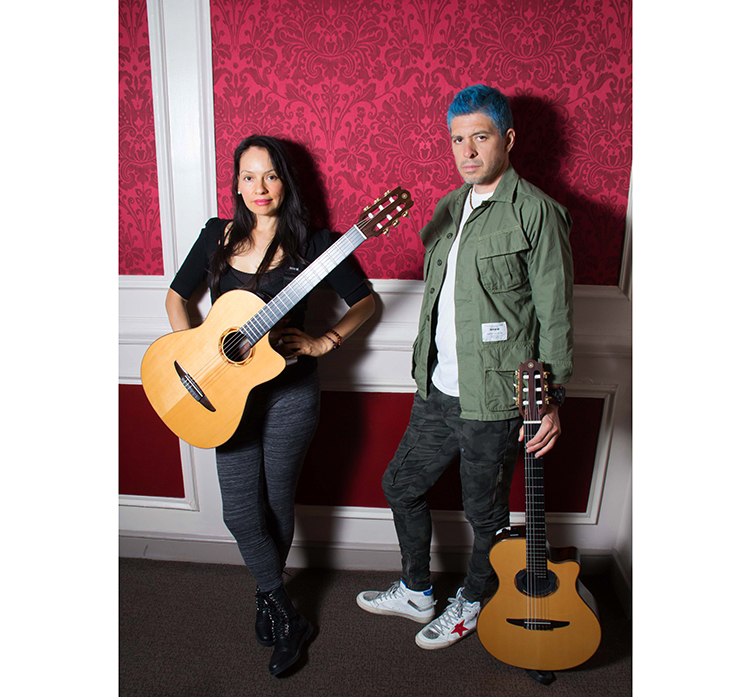
GG: (pointing to some quite advanced plectrum-scratches on the upper bout of Rodrigo’s guitar) I’m loving this!
RS: Haha, yeah!
GQ: And this (Gabriela’s guitar, which I believe is a custom model based on either a Yamaha NCX2000 or NCX1200) is thicker and bigger, because it just gives more body to everything.
RS: This one is eleven years old.
GG: This particular guitar?
RS: Yes, Rodrigo number two.
GG: Brilliant, and (to Gabriella) how old is this one? Same age?
GQ: Hmm, let me see... (looks inside the sound hole to the label) 2002.
GG: Wow. It’s just that you’re thumping this guitar and it looks brand new. And you (to Rodrigo) are picking yours and it’s absolutely destroyed!
RS: Haha, exactly!
GQ: Haha, yes because generally I play here, this is where I do my (taps the guitar in the previous place, with an entirely new rhythmic technique).
GG: Right, I need to know what you’re doing there! Haha!
(Gabriella graciously shows me, once again, a fantastic percussive technique. I watch very closely and lament the use of my phone as audio recorder because now I can’t take video to watch later and learn from!)
GQ; It’s just like a triple thing that you can practice. If you mute the strings, you can go with the middle and the ring finger and go down, coming back up with the thumb. It means you get three percussion sounds in one (clicks fingers) beat.
(starts playing it)
GG: Oh, wicked! That’s the sound!
GQ: That’s the sound! And it has come mostly from the Bodhran. Although flamenco guys do this, but they do (shows me another method). Those motherfuckers, those great flamenco players, they do the same shit but with (alters hand) this instead.
GG: Are you both naturally right-handed?
RS: Yeah.
GQ: Well, when I was a little girl I was left-handed, but somebody changed me so since then I was confused, like dyslexic, but then every time someone asks me ‘What does your left hand do?’, I’m just like ‘oh, well this will be just for chords!’ hahaha!
GG: Haha! So you may once have been left-handed, but they changed you.
GQ: Yeah.
GG: So, what I’ve noticed when trying flamenco techniques is that my right hand (I’m left-handed but play right-handed) ring finger doesn’t move as well as the one on my left hand. I try (demonstrates a frankly terrifying-looking rasqueado movement with right hand bent like Quasimodo) and I can’t get it.
RS: Oh, you cannot get it!
GG: How about you guys?
GQ: Me neither!
GG: Whaaaat? That was my excuse! My left-handedness!
RS: Haha!
GG: I can’t do it, but if you can’t do it either, there goes my excuse!
GQ: (sounding disappointed) I can’t do it...
GG: What about you, Rodrigo?
RS: (trying to stretch that right-hand ring finger out on its own) Aaaahhhh...
GG: You can kind of do it, you’re getting there!
RS: Yeah! I’m getting it! Haha!
GG: I think these fingers (ring and pinky) are on the same tendon, when those (index and middle) have their own...
RS: Yeah, exactly.
GQ: But those Flamenco guys, they do it. It’s very strong.
GG: I don’t think you have to worry about competing with those guys! I think you’re doing quite alright.
GQ: Hahaha!
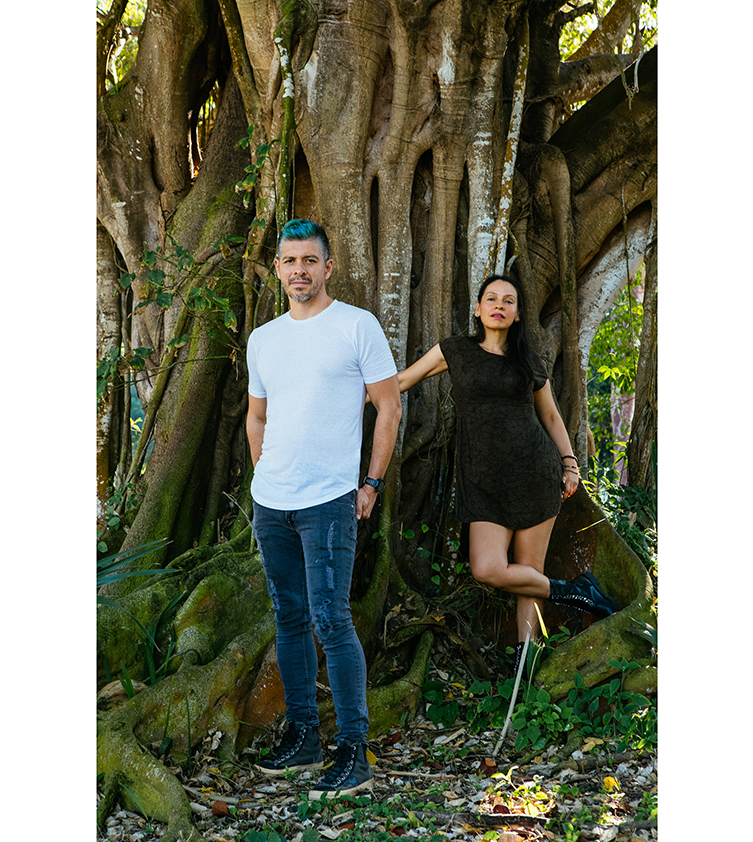
GG: So, moving away from guitars, and even music, what kind if things inspire you guys? We’ve talked about the concept of Mettavolution, the inward journey, the advancing of humanity, but what things inspire you guys to pick up and play? Is it places? Movies? Books?
RS: Nowadays, I mean we both probably have a different answer to that...
GQ: Totally different answer to that! Haha!
RS: But what inspires me is that fact that we can actually give: we can share this gift with people, and as I said at the beginning of the show, try to inspire them, doing whatever they do better. So, nowadays, it’s more about giving. Like, it doesn’t really inspire me to think that I want to play in whatever venue, because probably we’ve already played it, haha! So, it’s not about selling a million records anymore. It’s not about me. Even if I’m really tired it’s about ‘go out there and give’, you know?
GG: Yeah, it’s like there’s something bigger.
RS: Exactly! Exactly!
GG: And it comes about because of you guys, but it’s something that you’re still a part of.
RS: Exactly.
GQ: I think, before you play, play live, whatever, like when you were a little kid, and you first saw the guitar, there is something that draws people to play it. And then to come up with some melody, whatever it is. And I think that depends on every person. But, in my case particularly, there’s many things...like, sometimes, when you connect with a place...we’re going to go into the hippy mumbo-jumbo here...
GG: Go for it!
GQ: Like if you feel the energy of the place. We travel so much, or even when we are at home and we have the big trees, and there’s energy there with the ocean and stuff, all those things draw you to sort of go into introspection. That’s what makes you go and play, without thinking. It’s just...go and play!
GG: Like a download from nature.
GQ: Yeah, yeah, but also, some cities. Some places take you to this ‘wow’, you feel this ‘wow’!
GG: And when you go back to the same cities, do you feel the similar type of energy you felt before?
GQ: Yeah, yeah, like for instance, when we come back to the UK, Ireland, Scotland, some places just have this incredible energy and some cities too, you know? And buildings, even! We’ve been in Bath, in England, and it’s such an old city, I had such weird dreams!
GG: Bath, in particular, has got a ‘thing’ about it!
Both: Yeah!
GG: Graham Hancock lives there, the author. You know him? Fingerprints of the Gods?
GQ: Oooh yeah, yeah, yeah! That’s right! You see? Haha!
RS: Nice, haha!
GQ: So, I think those things, and mostly music itself is also something that inspired us to play. Sometimes we listen to classical music, anything like...Led Zeppelin.
GG: Ah, Led Zep! I’ve been working on a Jimmy Page blog today for the site, and you know all about his occult dabblings, right?
Both: Yeah.
GG: And how he bought Boleskine House up at Loch Ness here in Scotland, right? Aleister Crowley’s house?
GQ: Oh, yes!
GG: And so, my research led me to a site that said that the thing to remember with all of Jimmy Page’s practices, his energy-summoning on stage and so on, was that it was all for the power of good.
RS: Ah, no dark magic.
GG: Exactly!
GQ: And Crowley too. But he couldn’t find the path...
RS: I’ve been reading a book...
GQ: Like, people believed it was bad, but...
RS: I’m reading a book about him and I wouldn’t be totally sure about that fact that...I mean, because he was a little delusional at some points, and I don’t think...we he started losing it, you know, he wasn’t really...he was affecting other people, you know what I’m saying?
GG: Mm-hmm.
RS: So, I don’t know about that. I just bought that book recently, and even when I read him...
GQ: What is the name of the book?
RS: I think it’s a biography...
GG: Of Aleister Crowley?
RS: Yeah.
GQ: Really?
RS: Yeah.
GQ: I didn’t know you were reading about that.
RS: Yeah, I bought it recently.
GG: He’s keeping it secret!
RS: Yeah! Haha!
GQ: Hahaha!
RS: I bought it recently and, even when I grab it, you know, sometimes I feel a little bit like (makes an apprehensive, ‘uncertain’ sound) ‘Aaaaaahhhh’ hahaha!
GG: (to Gabriela) Keep an eye on him, ok?
Both: haha!

GG: So: one last question. What was it like working with Hans Zimmer on the Pirates of the Caribbean movie?
RS: Great! He has a great sense of humour, he is uh, an amazing musician, he was great! I mean, he was super normal!
GQ: Well, not that normal! He’s a character.
RS: Yeah, he’s a character in his own way.
GQ: But it was a good experience for us as musicians. We met also a producer there, Peter Asher, and we worked with him. And Peter is from the generation of Mick Jagger, and he is friends with Paul McCartney: that generation.
GG: The big guys!
GQ: Yeah, and these musicians are from Rock n Roll. And he was like, ‘there’s something I don’t understand about working here: all the music is in slave to the film, to the images!’ And for all musicians, it’s like the music that’s the important thing, and for them, music is the opposite. That was very interesting to experience. And even Hans Zimmer, who is like the god or the king of all of these blockbusters, he was working on about five films at once! He was working on Pirates of the Caribbean and Batman, and Kung Fu Panda! At the same time in the same building with different musicians.
GG: Even that’s a good lesson, isn’t it?
GQ: Yeah, but even like that, he’s like ‘whatever they do, I need to wait for the approval of the producers!’ And some of those producers are like completely musically ignorant!
GG: Really?
GQ: Yeah, so it was funny like that, right?
RS: Yeah!
And with that, Carlo came back in and announced that sadly, my time was up! Other people were outside waiting for their time with Rodrigo and Gabriela. We said our goodbyes and I left through the empty venue, out into the blackness of the Glasgow night.
I was very impressed with both Rodrigo and Gabriela: the show had energised them, rather than tired them out. After twenty years of performing acoustic gigs together, they showed up with full passion, enthusiasm and dedication. They certainly didn’t phone it in, and I think that also shows in the chat we shared: both of them were bright and engaging, with plenty to say and share, neither of them taking themselves too seriously.
Mettavolution may well be their grandest statement to date, and makes a lot of sense in the world we currently find ourselves in. They are currently on tour so head over to the official Rodrigo y Gabriela website to see where they are playing next.
We’d like to thank Rodrigo and Gabriela for agreeing to talk to us, to Carlo Polli for his help on the night, and to Tony at Yamaha and Roger Quail for everything they did to organise this special night for us.
Until next time.



